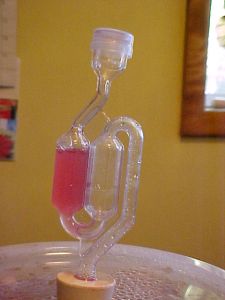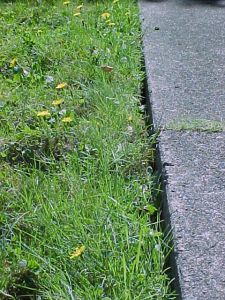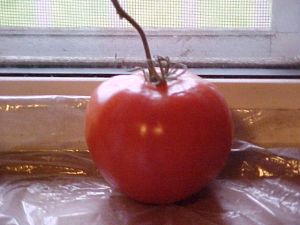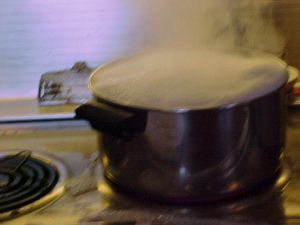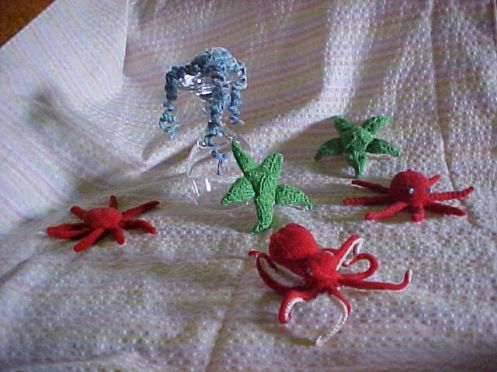
The Whole Rowdy Crew
I’ve been knitting socks, and decided that I needed to learn more about short-row shaping. Hence these creatures, Read more…
1 November 2014
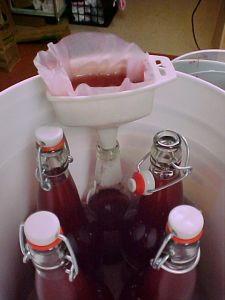 My bottling apparatus – that’s a paper coffee filter in the funnel, to catch any lees that I might ladle out of the fermentation bucket. / Mi equipo para embotellar – es un filtro para café, de papel, en el embudo, para coger cualquier de los sólidos que pueda servir del cubo de fermentación. / Mon appareil à mettre en bouteille – c’est un filtre de papier pour café, pour attraper à des sédiments que je peux servir du vaisseau de fermentation. / Mein Flaschenabfüllenapparat – das ist eine Kaffeefilterpapier, um etwaige Hefe, das ich schöpfe aus, zu fangen. Read more…
My bottling apparatus – that’s a paper coffee filter in the funnel, to catch any lees that I might ladle out of the fermentation bucket. / Mi equipo para embotellar – es un filtro para café, de papel, en el embudo, para coger cualquier de los sólidos que pueda servir del cubo de fermentación. / Mon appareil à mettre en bouteille – c’est un filtre de papier pour café, pour attraper à des sédiments que je peux servir du vaisseau de fermentation. / Mein Flaschenabfüllenapparat – das ist eine Kaffeefilterpapier, um etwaige Hefe, das ich schöpfe aus, zu fangen. Read more…
3 October 2014
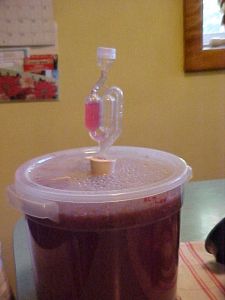 As I said, enthusiastic bubbling! Wine has pushed water out of the airlock. And it’s a rosé, thanks to the Concord grapes. Per instructions, I poured the wine through a sieve into a clean fermentation bucket, washed and re-attached the lid and airlock, and put nearly a cup of soaked, pink petals and lemon peel in the compost pile.
As I said, enthusiastic bubbling! Wine has pushed water out of the airlock. And it’s a rosé, thanks to the Concord grapes. Per instructions, I poured the wine through a sieve into a clean fermentation bucket, washed and re-attached the lid and airlock, and put nearly a cup of soaked, pink petals and lemon peel in the compost pile.
Como hé dicho, ¡un burbujeado entusiastico! El vino ha empujado al agua afuera de la esclusa de aire. Y es un rosado, gracias a las uvas Concord. Según las instrucciones, eché al vino por un colador en un cubo limpio para fermentación, lavé y puse de nuevo el cobre y esclusa, y puso un cuartolitro de petales y cascara de limón, rosas y remojadas, en el abono para jardín.
Comme j’ai dit, grand enthousiasme! Le vin a poussé à l’eau dehors de l’exclurer d’aire. Et c’est un rosé, grace aux raisins Concords. Selon la recette, j’ai versé au vin à travers du tamis, en vaisseau propre de fermentation, lavé et rémis le couvre et l’exclurer, et j’ai mis dans le jardin presque une tasse de pétales et écorce de citron, trempés et teindrés couleur de rose.
Wie habe ich gesagt, sehr begeisterlich gesprudeling! Der Wein had das Wasser von den Luftausschließer geschievt. Und der Wein ist einen Rosig, wegen die Concordtraubensaft. Par die Anweisungen, der Wein ist durch einer Sieb im eines sauber Gärunggefäß gegießt, der Deckel un Luftausschließer gewascht und ergesetzt sind, und ich habe um eine Tasse durchgemäßt und rosa-gefärben Blumenblatt und Zitronenschale im Garten gewerft.
5 October 2014
As soon as I removed the petals and lemon peel, fermentation slowed ‘way down; the water is almost level between the 2 chambers of the airlock. Is that right? Is it growing mold, or otherwise spoiling? It isn’t producing any bad smells . . . . I just have to wait for 3 weeks.
Tan pronto que saqué a los petales y la cáscara de limón del vino, la fermentación se retrasaba mucho; el nivel del agua está casi igual dentro de los dos lados del esclusa de aire. ¿Debe estar así? ¿Deja crecer un moho, o de otra manera se estropea? No produce ningún olor malo . . . . Ahora necesita esperar tres semanas mas.
Aussitôt que j’ai enlevé des pétales et l’ecorce du citron, la fermentation se retarde beaucoup; le niveau d’eau est presque égale dentre les deux chambres de l’exclurer d’aire. Á ce-la du raison? Laisee-il pousser une moisissure, ou autrement se gâche il? Il ne produit rien d’odeur que sent mauvais . . . . Maintenent il faut qu’esperer 3 semaines.
Sobald hatte ich die Blumenblatten und Zitronenschale von dem Wein herausgenommen, die Gärung viel verlansamtet; das Wasser ist zwischen die zwei Kammeren des Luftausschließer fast gleich. Ist das richtig? Wachst einer Schimmel? Oder in anderer Weise verderbt sich es? Es produziert keiner Schlechter Duft . . . . Jetzt mußt es um drei Wochen warten.
The Experiment:
Yeah, I know, dandelion wine is something one makes in the Spring! But here it is October and they’re still blooming, so what else could I do? I started my first batch with a recipe of John Wright, printed in the Guardian / ¡Que sí, yo sé que el vino de flor del dente-de-león es algo que uno hace en la primavera! Pero aquí estamos en octubre, y ya florecen; ¿Qué otro podía hacer? Hice mi primer tentativo con ésta receta (en inglés) / Je sais bien qu’on fait le vin du dent-de-leon dans le printemps, mais c’est octobre, et toujours ils fleurent; ainsi, quoi d’autre peux-je faire? J’ai commencé le première fournée avec cette recette / Ja, ich weiß, man macht den Löwenzahnwein im Frühling! Aber hier sind wir im Oktober, und noch bluhen sie; so, was sonst kannie ich denn tun? Zu der erster Satz, ich dieses Rezept folgete: http://www.theguardian.com/lifeandstyle/wordofmouth/2012/apr/04/how-to-make-dandelion-wine Read more…
El vigor híbrido . . . ¿o ser de otro planeta? / La vigeur hybride . . . ou un estraterrestre? / Die hybrid Kraft . . . oder von das Weltall?
I bought this tomato at a supermarket, in October. Never again. Neither the color nor the texture have changed at all. Saturday, I put it in the compost pile. / Comprí este tomate de un supermercado, en octubre. Nunca jamás. Ni el colór ni la textura no han cambiado, de ninguna manera. El sábado, lo puse en el abono para el jardín. / J’ai compris de tomate du supermarché en octubre. Jamais plus. N’était rien de change ni du couleur ni de texture. Le samedi, je l’ai jeté dans les ordures pour le jardin. / Ich habe diese Tomate vom Supermarkt gekauft, im Oktober. Nie wieder! Weder die Farbe noch das Gefüge haben sich veränderet gar nicht. Am Samstag, ich es werfte im Gartenmüll.
The only sign of ripening it has shown, are the tiny dots of white mold around the stem. I don’t want to know what it looks like inside. / La única muestra que ha dado de madurarse, es los puntitos de moho blanco, alrededor del tallo. No quiero mire al interior. / Le seule signe de change qu’il à montré, est les très petits points de moisissure, autours de la tige. Je ne veux pas voir, comme se semble l’interieur. / Das einig Kennzeichen, zu rufen lassen, das es hat gezeicht, ist die winziger Punkten weiß Schimmel, ringsherum dem Halm. Ich wille nicht kennen, wie seht die Innensiete.
Observaciones al Azar – Observations au Hasard – Aussichtsturmen aufs Geratewohl
Washing your gauge swatches in hot, soapy water is very important. Guessing how much they’ll shrink is useless. / Es muy importante, lavar los ejemplos en el agua caliente con jabón. Es inútil, intentar adivinir cuanto van a encogerse. / C’est trés important, qu’on laver les échantillons au l’eau chaud et savonneux. C’est inutile, conjecture combien ils se rétrécent. / Es ist wichtig, daß die Strickproben gewascht sind in Heißwasser und Seife. Schätzen wieviele sie einschrumpfen, eines falsch Eschmaß gibt.
Part of my problem with the top of this hat is that I mis-read the tam-o’-shanter pattern. It actually has not 6 decreases, but 6 double decreases, or 12 single decreases, every second round. I didn’t figure this out until I’d knit 4 more hats. / Parte de mi problema con la cima de este sombrero, es que me equivoqué en leer al patrón para el tam-o’-shanter. En realidad el tiene, no 6 diminuciones, sino 6 doble-diminuciones, o diminución de 12 puntos, en cada 2 vueltas. Eso yo no me expliquía hasta que había tricotado 4 sombreros más. / Une parte de mon problème avec le haut de cet chapeau, est que j’ai mal lu les instructions pour le tam-o’-shanter. En fait, il n’a pas 6 diminutions, mais 6 double-diminutions (12 points diminués), chaque 2 ronds. Je ne comprendis pas cela, avant que j’avais tricoté 4 chapeaux plus. / Eines Teil meines Problem mit der Spitze dieses Hut, ist das ich habe falsch gelesen die anweisungen für der Tam-o’-shanter. Wirklich es habe nicht 6 Abnehmen, sondern 6 Doppelabnehmen (12 Normalabnehmen) in jedes zweite Runde. Ich hatte es nicht ausgenobelt, bis hatte ich vier mehre Hüt gestrickt.
The alternating knit-and-purl stitches in the first row turned out to be unnecessary; when I joined the edges of the brim, the two layers pulled against each other and flattened out nicely. / Resultó que la “pretina elastizada” al principio no fue necesario; cuando juntaba los bordes, las dos capas se tiraban el uno contra el otro, y se aplanaron bien. / Se termine que les “côtes” du premier rond n’ont pas necessaire; quand j’ai uni aux deux bords, les deux couches s’ont tiré l’un contre l’autre, et s’ont aplanus bien. / Es stellte sich heraus, daß das Rippenmuster in der erste Reihe, was unnötig. Wann ich die Kanten zusammen strickte, sie gegen einander zieheten, und sich gut abplatteten.
Para bloquear al sombrero (2) – Pour bloquer au chapeau (2) – Um der Hut zu formen (2)
Six hours later, the hat felt dry enough to try on . . . it was smaller than it had been before its hot bath, but still loose. I put my kitchen utensils away and spread the hat out flat on towels, which I changed twice over the next day as they became soaked. Then, using a cotton cloth to cover the hat, I steamed it almost dry on the wool/silk setting of my iron, then left it to finish air-drying. / Seis horas mas tarde, el sombrero se sentí bastante seco para probar . . . estaba mas pequeño que antes su baño caliente, sino todavía suelto. Puse en sus sitios mis herrameintos de cocinar, y puse al sombrero plano en toallas, las que cambió dos veces sobre el proóximo día cuando se hacían mojadas. Después, usando una tela de algodón para protegerlo, planché al sombrero en el ajuste para lana y seda, hasta casi seco, y lo dejé para secarse completamente en el aire. Read more…
Para bloquear al sombrero en tamaño correcto – Pour bloquer au chapeau – Um der Hut zu formen
After 20 minutes, I took the hat out of the hot water, put it in a strainer under the cold tap, and ran cold water over it until it was cooler than room temperature (about 60°F / 15° C). Then I pressed all possible water out of it between terry-cloth bath towels, and laid it out to dry. / Después de 20 minutos, saqué al sombrero del agua caliente, y lo puse en un colador bajo la grifa fría, hasta que estaba mas frío que la cocina (cerca 15° C). Después, lo enrollé entre toallas de baño, para sacar todo el agua posible, y lo coloqué para secarse. / Aprés 20 minutes, j’ ai enlevé le chapeau de l’eau chaud, et le mis dans un tamis en dessous du robinet froid, jusqu’à été mais froid que la cuisine (vers 15° C). Puis je l’ai pressé entre deux serviettes de bain, pour exprimer tout l’eau possible, et le mis pour se sécher. / Nach 20 Minuten, ich den Hut herausnimmte des Heißwasser, und es liegt in einer Sieb ünter dem Kaltwasserhahn, bis war der Hut kalter als den Zimmer (um 15° C). Dann ich das überschussige Wasser zwischen swei Frottee-handtucher ausdrückte, und es zu austrocknen umgeliegte. Read more…
Para Hacer Fieltro al Sombrero / Pour Faire Feutre au Chapeau / Der Hut zu walken
While the water heated, I soaked the hat in cold water. / Mientras el agua se calentó, dejé al sombrero remojarse en agua fría. / Pendent que l’eau se chauffait, le chapeau trempait en l’eau froid. / Während das Wasser bewegte sich huß wurde, der Hut sich weicht in kalte Wasser.
I started with 2 quarts water and a generous teaspoon of liquid soap, in my 1-gallon soup pot. / Empezé con 2 litros de agua y una cucharadita generosa de jabon lícuido, en mi olla de sopa de 1 gallon. / J’ai commencé avec 2 litres d’eau et une petite couillière généreusement pleine de savon liquide, dans ma marmite de soupe de 1 gallon. / Ich habe mit 2 Liter Heißwasser und ein Teelöffel-und-wenig flüssig Wäschseife, in meinem 1-gallone Suppekessel.
It’s important to have a large-enough pot. I transferred the hot water to a 2-gallon canning kettle, and added another cup or so of water, to compensate for what spilled. When the water was again almost hot enough to boil (about 200°F/93°C), I put the hat in, and cooked it for 20 minutes, keeping it under water and stirring it around with a potato masher. (The plastic’s heat-resistant, of course, but I don’t think it should go in water that’s actually boiling. I’m now looking for a metal one.) / Importa que la olla sea bastante grande. Puse el agua en otra olla de 2 galones, con otra copa de agua, para compensar por lo que derramó. Cuando el agua estaba de nuevo casi a la hierva (cerca 93°C), puse el sombrero y lo cociné durante unos 20 minutos. Importa que el sombrero sea debajo del superficie del agua, y que sea revuelto con frequencia. / Importe que la marmite soit assez grande. J’ai transféré l’eau a une marmite de 2 gallons, et ajouté encore une tasse d’eau, pour compenser cela que s’a répandé. Quand l’eau été encore presque chaud pour bouillir (vers 200°F/93°C), j’en ai mis le chapeau, et le cuisinié pour 20 minutes. / Es wichtig, das der Kessel genug groß ist. Ich das Wasser bewegte im grosser Kessel, und ein anderer Halbliter Wasser hinzufügte, um für was verschuttet zu entschädigen. Wann war das Wasser fast siedende, ich insetzte der Hut, und es kochte eines 20 Minuten, es haltende unterwasser auf mit einem Kartoffelbreier. (Naturlich ist das Plastik heißwiderstehen, aber ich glaube nicht, das es soll in kochender Wasser gehen. Ich suche jetzt einem von Metall.)

